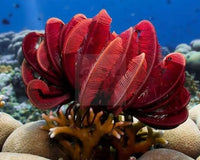Aquarium enthusiasts and marine life hobbyists are often enchanted by the vibrant beauty of Caribbean anemones, specifically those belonging to the Condylactis spp. family. These fascinating creatures not only add an eye-catching element to your reef tank but also play a crucial role in the healthy ecosystem of your aquarium. In this guide, we will explore the care and maintenance of Caribbean anemones, ensuring they thrive in your aquatic environment.
Understanding Caribbean Anemones
Caribbean anemones are commonly known as sea anemones and are famous for their ability to form symbiotic relationships with clownfish, offering shelter and protection in exchange for food scraps. Native to the warm waters of the Caribbean, these anemones thrive in a variety of marine environments, making them a popular choice for reef tanks.
Setting Up the Ideal Environment
Before introducing a Caribbean anemone into your aquarium, it is essential to create an environment that mimics their natural habitat. Here are the key factors to consider:
1. Water Quality
Maintaining the right water quality is vital. Anemones require stable salinity levels between 1.020 to 1.025 specific gravity. Regularly test and monitor parameters such as pH (between 8.1 and 8.4), ammonia, nitrite, and nitrate levels, as well as calcium and magnesium concentrations. Regular water changes should be performed to keep toxins at bay.
2. Lighting Conditions
Caribbean anemones require bright lighting that replicates their sunlit home in the ocean. Using high-quality LED or T5 fluorescent lights will allow photosynthetic algae (zooxanthellae) within the anemones to thrive. Aim for a light cycle of approximately 10-12 hours daily for optimal growth.
3. Water Flow
Proper water flow can significantly impact the health of your Caribbean anemone. A gentle to moderate water flow is ideal, mimicking the natural currents of the ocean. Strong currents can cause trauma or dislodge the anemone from its preferred position in the tank. Use adjustable powerheads to create the right flow conditions.
Introducing Caribbean Anemones to Your Aquarium
Once you’ve established an optimal environment, it’s time to introduce your Caribbean anemone. Make sure to purchase your anemone from reputable suppliers like Marine World Aquatics, ensuring that you are getting a healthy specimen.
Before placing the anemone in your reef tank, float the sealed bag in the aquarium for about 15-20 minutes to acclimatise it to the water temperature. Gradually introduce water from your aquarium to the bag. After about another 30-60 minutes, gently place the anemone in its desired location, ensuring it is not in direct line of strong currents.
Feeding Your Caribbean Anemone
Caribbean anemones are carnivorous and require a steady diet to thrive. In a home aquarium, they can be fed a variety of foods, including:
- Marine pellets or flakes
- Frozen or live mysis shrimp
- Chopped fish or shrimp
- Brine shrimp
- Other small meaty foods
Feed your anemone two to three times a week, ensuring the pieces are small enough for it to digest. Overfeeding can lead to water quality issues, so monitor the quantity closely.
Common Challenges and Solutions
Despite their resilience, Caribbean anemones can face challenges in captivity. Here are some common issues and solutions:
1. Anemone Recessing
If your anemone begins to retract or hide, it may indicate stress. Check water parameters immediately, as poor water quality is often the culprit. Providing proper flow and light conditions can also alleviate stress.
2. Aggression from Tank Mates
Some fish and invertebrates might harass anemones, leading to injury or stress. Research potential tank mates before introducing them to your aquarium. Consider placing the anemone in a separate area where it has enough space to avoid aggressive tank mates.
3. Bleaching
Bleached anemones have lost their colour and are often a sign of distress or inadequate lighting. Ensure that your lighting system provides sufficient intensity and spectrum for the health of the anemone. Adjust light duration, ensuring they receive proper light without overheating.
Long-Term Care and Maintenance
Care for Caribbean anemones doesn’t stop after installation. Regular monitoring and maintenance of the aquarium environment are key to their long-term health. Stay dedicated to water quality tests, routine feeding, and searching for potential issues early.
Additionally, proper tank mates, like clownfish, can enhance the anemone’s overall health, as they provide food and agitation, which encourages the anemone to expand.
Conclusion
Caring for Caribbean anemones in your aquarium can be a rewarding experience for marine life hobbyists and reef tank owners. By providing the right environment, proper feeding, and regular maintenance, your anemone will flourish. For purchasing healthy Caribbean anemones, visit Marine World Aquatics today and enhance your aquarium with this stunning marine life.





